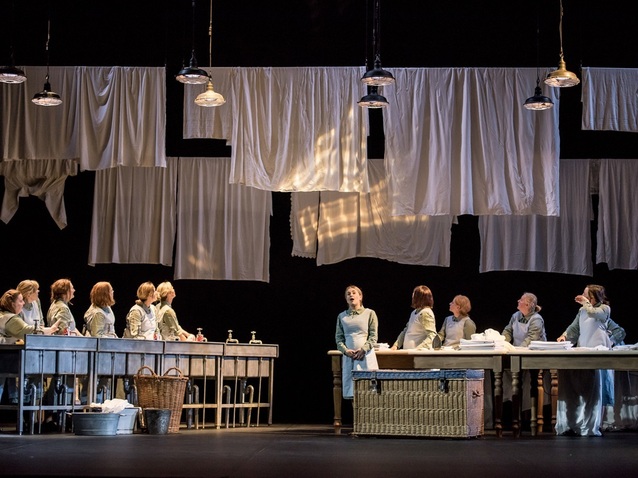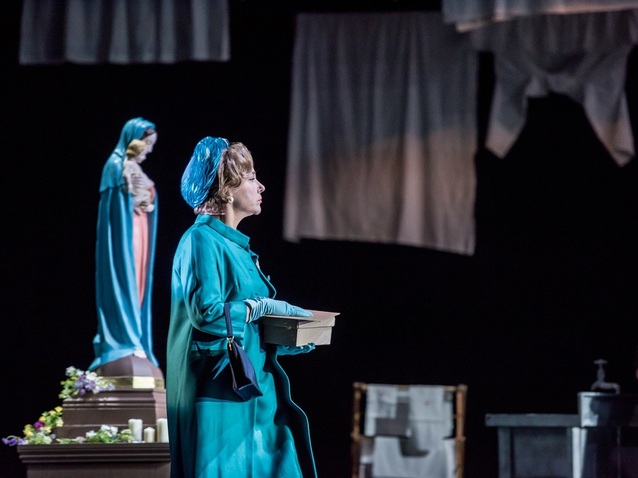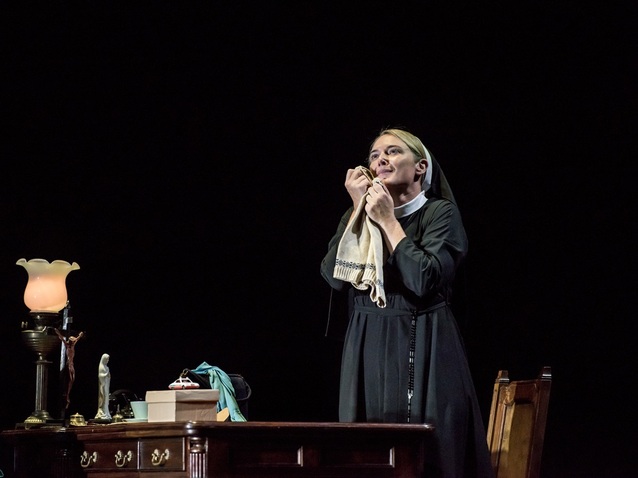 © Geneviève Girling
© Geneviève Girling
Giacomo Puccini’s Il trittico, which premiered at the Metropolitan Opera in 1918, is a triptych of one-act operas comprising Il tabarro, Suor Angelica and Gianni Schicchi. The composer originally intended for each opera to reflect one part of Dante’s Divina Commedia, although in the event only the final work is based on the poem. As a result, the only theme that really underpins the operas is that they all involve, in one way or another, the concealment of a death.
Although Puccini intended that the three should be performed as a set, it is not unusual for only two of them to be presented in an evening, or for one to be staged with another one-act opera. For example, Richard Jones presented Gianni Schicchi at the Royal Opera House in 2007 and 2009 along with Maurice Ravel’s L’heure espagnole before staging the same production of Gianni Schicchi as part of the complete triptych in 2011.

Christine Rice, ENO’s Suor Angelica 2024 © Genevieve Girling
Unusually, English National Opera presents Suor Angelica, which Puccini set to an original Italian libretto by Giovacchino Forzano, completely alone. Originally set in Italy in the seventeenth century, the opera tells of a nun who joined a convent after bringing disgrace upon her wealthy family by having a child out of wedlock. She fulfils her duties well in the pious establishment, but one day her Aunt, The Princess, arrives to instruct her to sign away her share of the family inheritance so that her sister who is about to marry may have everything. When Angelica refuses because she feels she cannot turn her back on her son, The Princess explains that he died two years ago. With nothing to live for, and wishing to join her son, Angelica signs the paper and poisons herself before realising that suicide is a sin. Before she dies, however, she believes that she sees the Virgin Mary with her son and that she has been forgiven.
Director Annilese Miskimmon sets the action in 1960s Ireland in a Magdalene Laundry. Between 1922 and 1988, 80,000 unmarried mothers were abandoned by their families and forced to enter convent-run mother and baby institutions. These were often attached to the notorious Magdalene Laundries where the women were separated from their children at birth, and forced to work without pay for years. Thus, although the action is updated by three hundred years, the society as a whole is just as harsh in terms of how it judges having a child out of wedlock. In line with the overall set-up, Yannis Thavoris’s set suggests that while the focus of convent life should be on spirituality and prayer, in practice it can involve extremely hard and mundane work. We see novices washing clothes in sinks and others ironing, while the pure white linen that hangs above them bridges the gap between the temporal and divine. This is because it represents the convent’s infrastructure, with the golden sunlight that is described as falling on the cloister actually illuminating the linen, courtesy of Mark Jonathan’s lighting designs.

Sinéad Campbell-Wallace, ENO’s Suor Angelica 2024 © Genevieve Girling
There is a strong attention to detail as The Princess, referred to here as The Baroness, wears blue to match the convent’s statue of The Madonna. She is consequently set up to be at odds with the divine figure as her concern for her status, reputation and hence the secular puts her at odds with Christian teachings. At the same time, from her own point of view there are parallels as she would see herself as upholding strict moral values, and thus being possessed of Christian virtues. As lights fall on the statue of The Madonna on one side of the stage and The Baroness at a desk on the other, this tension could not be revealed more clearly. Christine Rice, with her sumptuous mezzo-soprano is an outstanding Baroness who gives both a commanding and subtle performance. While it is obvious that she knows what she needs to obtain and is focused on getting it, it is hard to judge her as being completely ‘evil’. This is because it is easy to see how her own attitudes have been dictated by the society in which she has been brought up, and it even feels as if she is tormented herself by having to do what is ‘expected’ of her. As this staging makes abundantly clear, the problem runs far deeper than the actions of this individual, and one imagines that in another time and place where different attitudes prevailed, her strong personality could actually be used as a force for good.
Conductor Corinna Niemeyer elicits an extremely balanced sound from the English National Opera Orchestra, and the most climactic passages towards the end feel both objectively powerful and emotionally intense. Alexandra Oomens, with her clear and beautiful soprano, stands out as Sister Genevieve while other notable performances come from Madeleine Shaw as The Abbess, Lea Shaw as The Monitress and Gaynor Keeble as The Mistress of the Novices. The opera, however, and this production in particular, provide the opportunity for many individuals to shine as they reveal their unique personalities through their moments in the ‘spotlight’ and interactions with others. At the heart of the evening stands Sinéad Campbell Wallace as Sister Angelica, who reveals a heavenly voice and immensely caring persona. She can never, however, quite mask the anguish she feels inside at her situation, and the ending in which she sees her son is heart breaking, as she constantly reaches out to the child but can never quite physically touch him.
By Sam Smith
Suor Angelica | 27 September 2024 | London Coliseum
the 29 of September, 2024 | Print
Comments